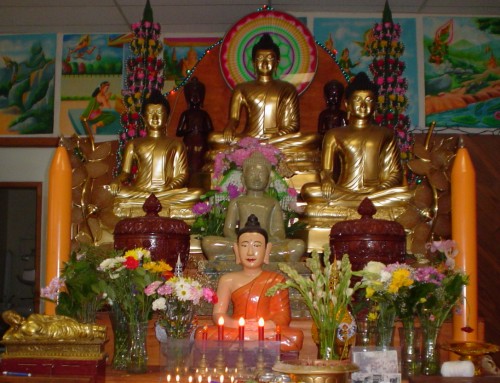|
Wat Bothiprikrattanarm on Market Street in north Long Beach (2007). |
Buddhism was introduced to Cambodia from India sometime prior to the Common Era. Many forms of Buddhism are practiced throughout the world. The earliest form introduced to Southeast Asia was Mahayana ("greater vehicle"), however the dominant form of Buddhism practiced in Cambodia today is Theravada ("way of the elders").
Cambodia is commonly thought of as being Buddhist since its origins, but Hinduism had tremendous influence during the Angkor period from the 9th to 13th centuries and continues to influence Buddhist practice in Cambodia today. Hinduism was probably introduced to Cambodia at the same time as Buddhism and by the 9th century had been adapted by local chiefs to enhance their spiritual and political authority. Hindu practice reached a peak in the magnificent 12th century temples of Angkor, most of which were dedicated to the Hindu gods Siva, known in Khmer as Preah Eyso, and Vishnu, known in Khmer as Preah Noreay.
|
|
Archaeological evidence suggests that while the elite were assimilating Hindu practices into Khmer statecraft, villagers were incorporating aspects of both Mahayana Buddhism and Hinduism into existing indigenous spiritual beliefs and practices.[i] It was not until after the Angkor period (c. 13th-14th centuries) that Theravada Buddhism became the dominant religion of Cambodia. Buddhism as practiced in Cambodia and the United States today is referred to as a "syncretic" religion, meaning that elements of indigenous Khmer (Cambodian) popular religious practices and Hindu practices are intertwined with Buddhist practices. |
|
|
In modern Cambodia, Buddhism was completely integrated into an individual's daily activities and the average villager's life was "regulated from birth to death by the Buddhist temple."[ii] Every village that could afford it had at least one Buddhist temple, or wat. In the countryside prior to 1975, the ideal was that every boy spend at least one year as a novice monk learning the teachings of the Buddha known as damma in Pali which is the liturgical language of Theravada Buddhism. It was in this way that young boys matured into manhood. The wat served not only as a place of worship, but also as the village school (generally for males only) and as the center of village social activities throughout the year. Buddhism's cultural, social, and personal importance for most Cambodians prior to 1975 can be summed up in the frequently heard saying, "To be Cambodian is to be Buddhist," a statement which reflects the far-reaching set of values toward family obligation, social hierarchy, and the afterlife that guide everyday interaction. |
|
|
The establishment of a Buddhist temple in Long Beach was critical for the emotional and mental health of Buddhist Cambodians, especially those who had lived through the Pol Pot time. In 1979, the Venerable Dr. Kong Chhean, who had been studying in India when Cambodia fell to the Khmer Rouge, was sponsored to the United States by members of the Long Beach community and set up in a small temple in an apartment in nearby Hawaiian Gardens. The first Buddhist temple located in the city of Long Beach was Wat Vipassanaram, established on Twentieth Street in 1985. Today there are more than ten Cambodian Buddhist temples of varying sizes serving different segments of the population within Long Beach. |
|
|
This section provides a history of the recreation of Cambodian Buddhist practices in Long Beach and images of various temples and annual ceremonies and other activities. Not all the temples in Long Beach are shown here, and more will be added over time. Suggestions for further reading are provided below. We invite anyone who would like to contribute documents, books, video, or photographs to the CamCHAP archive to please contact us at the Historical Society of Long Beach, 562-424-2220, email: |
|
Photo Gallery |
||
|
|
|
|
[i] Coe, Michael (2005) Angkor and the Khmer Civilization. New York: Thames & Hudson.
[ii] Chhang, Song (1995) Buddhism Under Pol Pot.
Further Reading
Douglas, Tom (2004) Crossing the Lotus: Race, Religion and Rationality among Cambodian Immigrants in Long Beach and Seattle.
Harris, Ian (2005) Cambodian Buddhism. Honolulu: University of Hawai'i Press.
Kong, Chhean ((2003) On Buddhism and Psychotherapy. IN Not Just Victims: Conversations with Cambodian Community Leaders in the United States. Sucheng Chan, Editor. Chicago: University of Illinois Press.
Mortland, Carol (1994) Khmer Buddhists in the United States: Ultimate Questions. IN Cambodian Culture since 1975: Homeland and Exile. May Ebihara, Carol Mortland, and Judy Ledgerwood, Editors. Ithaca, NY: Cornell University Press.
Ong, Aihwa (2003) Buddha is Hiding: Refugee, Citizenship, the New America. Berkeley: University of California Press.
Yamada, Teri (2004) The Spirit Cult of Khleang Moeung in Long Beach, California. IN History, Buddhism, and New Religious movements in Cambodia. John Marston and Elizabeth Guthrie, Editors. Honolulu: University of Hawai'i Press.

 ខ្មែរ
ខ្មែរ  English
English 


















